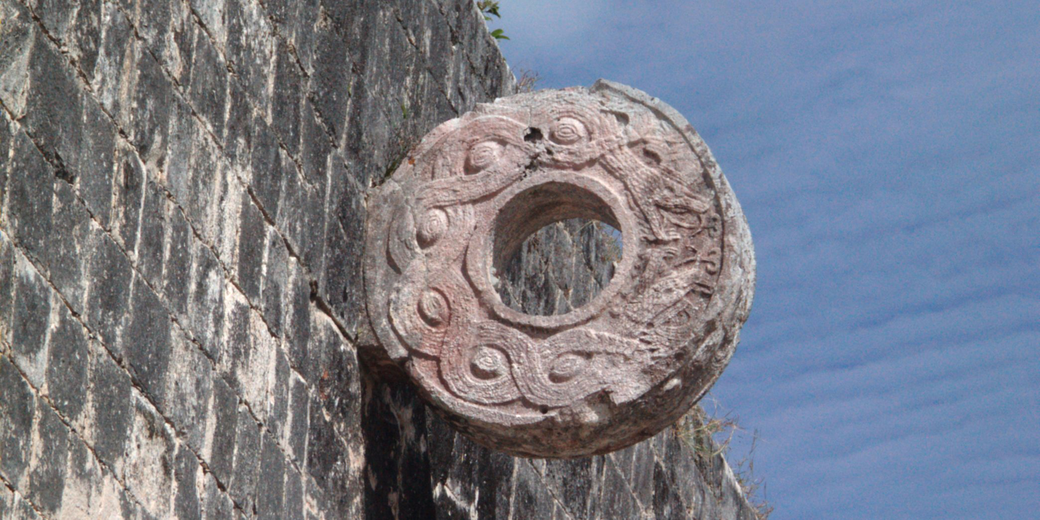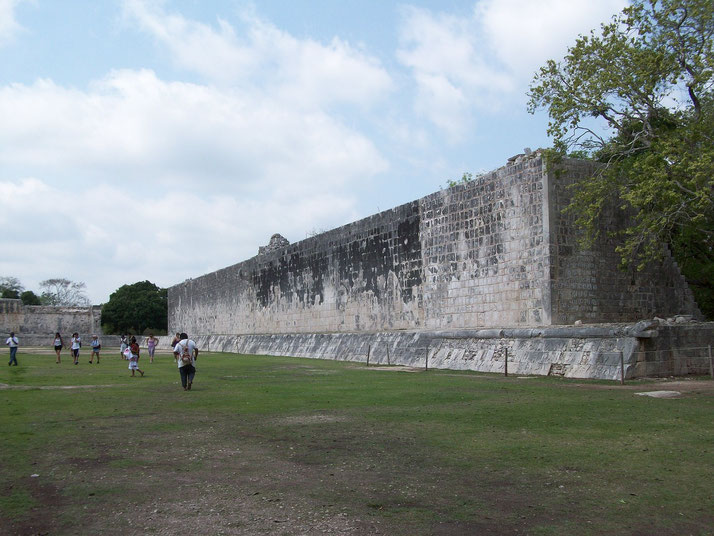The 'Mesoamerican Ballgame': The Aztec's favourite game of life and death

The Aztecs played a ballgame known as ōllamaliztli, which was played across sacred courts, where players used only their hips, arms, or thighs to strike a heavy rubber ball, often under the watchful gaze of priests and nobles.
Matches took place in carefully designed arenas that expressed religious beliefs about the universe, where every movement carried religious meaning.
What was the 'Mesoamerican ballgame'?
The Mesoamerican ballgame was a ceremonial team sport that involved striking a rubber ball without using hands or feet.
Players wore thick padding and attempted to keep the ball in motion, either by bouncing it off sloped walls or aiming it through stone hoops set high on the sides of the court.
The court itself had an I-shaped design, with flat central areas and angled walls that allowed the ball to rebound unpredictably.
Aztec courts often stood beside temples. In Nahuatl, the language of the Mexica, the game was called ōllamaliztli, from ōlli, meaning rubber.
Courts appeared in both large cities and provincial towns, where they were used as both athletic venues and ceremonial spaces.
Spectators filled the surrounding platforms during major festivals, while priests presided over the contests and ensured the rules were followed.
Teams of between two and seven players competed in matches that could last for hours.
Evidence of its popularity
Archaeologists have found more than 1,300 ballcourts across Mesoamerica, with the oldest dating back to around 1400 BCE at Paso de la Amada.
Later civilisations, including the Maya and Zapotec, developed their own versions of the game, but the Aztecs gave it political and religious prominence.
Spanish records confirm its widespread appeal. When Hernán Cortés travelled from the coast to Tenochtitlan in 1519, he observed the game being played in towns such as Cempoala and Tlaxcala.
The Florentine Codex, compiled by Bernardino de Sahagún, described the players’ costumes, equipment, and techniques.
It also recorded how nobles sponsored matches during festivals, and how common people watched and gambled on the outcome.
Evidence from murals, codices, and sculpture hs images of players on temple walls, household pottery, and ceremonial structures.
Some images show players wearing detailed headdresses or carrying representative weapons, which suggests the connection between the game and warfare.
Others depict the game as a contest between gods, which shows its traditional importance in mythology.
In Aztec society, participation in the game reflected one’s training and status.
Youths trained in the telpochcalli or calmecac sometimes learned to play as part of their preparation for adult life.
Elite players gained respect and could travel between cities to perform in ceremonial matches, while nobles used the game to display generosity and gain favour among their people.

The rules of the game
Although rules varied between regions, the Aztec version followed consistent patterns.
Each team attempted to keep the rubber ball in play by striking it with permitted parts of the body.
The ball could bounce off the court’s sloped walls, and in some courts, scoring a goal by passing the ball through a stone hoop ended the match at once.
These hoops were set high, often three or four metres above the ground, which made scoring extremely difficult.
Players avoided using their hands or feet, and any mistake could result in a penalty or point loss.
The ball could weigh several kilograms and caused serious injuries when misjudged.
Teams relied on coordinated movement, with players who formed patterns that rotated in sequence that allowed rebounds, traps, and defensive blocks.
Rules were sometimes adapted depending on whether the match was ritual or recreational.
In some cases, captives played against warriors, and the outcome determined whether they would live or die.
Other matches celebrated diplomatic agreements or royal ceremonies, and although they maintained ritual aspects, they focused more on spectacle than punishment.
Some versions rewarded the victors with prizes or public honours, yet others claimed the winners were sacrificed to the gods.
This idea comes from sources such as the Popol Vuh, which describes divine ballgames in the Maya underworld, but it remains debated.
Among the Aztecs, sacrifice occurred during certain ritual matches, but it was not a universal rule for every game.
The game's religious significance
The Aztecs believed that the gods had created the current age, known as the Fifth Sun, through self-sacrifice.
To keep the sun moving and the world in balance, humans had to repay this debt with offerings of blood and life.
The ballgame was a representative version of this exchange, and the court itself represented the cosmos.
The ball's motion echoed the sun's journey across the sky, while the court’s layout mimicked the space between heaven and the underworld.
Priests directed the ritual matches, offering incense that was set alight, chants that used sacred words, and ritual acts of sacrifice before play began.
They selected the players, decided the stakes, and explained the result. During major festivals, matches honoured gods such as Huitzilopochtli, Tezcatlipoca, and Xipe Totec.
Players became ritual players, and their performance was watched by the crowd and also by 'divine forces'.
Some courts were aligned to solstices or cardinal directions, while others included carvings that showed the decapitation of players.
Blood spilled on the court fed the gods, renewed heavenly energy, and allowed the Aztecs to fulfil their religious obligations.
In some traditions, being chosen for sacrifice after winning was considered the greatest honour.
It showed that the gods had accepted the offering and that the player's life held sacred value.
Impact of the Spanish conquest
When the Spanish destroyed the Aztec Empire in 1521, they disrupted every institution that gave meaning to the ballgame.
Missionaries condemned it as idolatrous, while colonial officials outlawed sacrifices and destroyed temples.
Although some courts remained standing, they lost their ritual function and remained as quiet reminders of a lost civilisation.
In the early decades of colonial rule, indigenous communities played modified versions without religious rituals, and Spanish audiences sometimes attended these games out of curiosity.
Over time, however, restrictions tightened. Fewer courts were maintained, and the representative meaning of the game faded from public life.
By the seventeenth century, most ballcourts had fallen into ruin.
Today, a revived version called ulama survives in parts of Mexico. Historians and archaeologists continue to study the original specific rules, physical materials, and representative interpretations from different societies.
Reconstructed courts and public demonstrations help to preserve knowledge of a game that once played an important part in Aztec religious life.
What do you need help with?
Download ready-to-use digital learning resources
Copyright © History Skills 2014-2025.
Contact via email
With the exception of links to external sites, some historical sources and extracts from specific publications, all content on this website is copyrighted by History Skills. This content may not be copied, republished or redistributed without written permission from the website creator. Please use the Contact page to obtain relevant permission.





